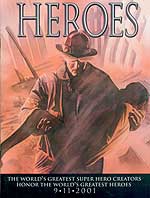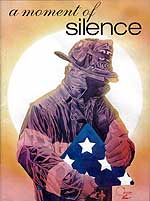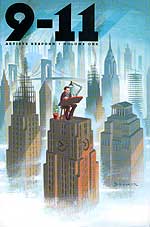Well, they did. Both the DC and Marvel projects include the characters their business has been built on. It really should come as no surprise, after all, superheroes are what they do. For some this will come across as a gross commodification and trivialization of an awesome, unspeakable tragedy. These characters are arguably more corporate icons than meaningful characters — like seeing Ronald McDonald and the Keebler Elves giving succor to victim's families. But I think it is more complicated and interesting than that.

|
DC smartly confronts this issue right up front in its book "9-11: The World's Finest Comic Book Writers & Artists Tell Stories to Remember" ($9.95; 224pp.) Superman, trapped in the pages of a comicbook, laments his inability to "break free from the fictional pages where I live and breath...become real during times of crisis and right the wrongs of an unjust world." Left behind as a fireman rushes into the flames, he adds, " A world fortunately protected by heroes of its own." When Superman, who has entered into the (inter)national consciousness as an emblem of American strength and goodwill, modestly salutes real heroics it feels right.
Only about half the book involves DC characters. The rest are personal recollections, like Andy Helfer's "Careful," about becoming temporarily homeless after the WTC collapse, or more fanciful reactions to the events. Several of these have a curiously militaristic edge that makes the DC book the most politically conservative of the 9/11 projects. Bizarre on several levels, Marvel's emeritus editor and comics legend Stan Lee contributes a "lost" Aesop fable with a non-too-subtly-chosen "gentle and caring" elephant taking rampaging vengeance on some dastardly mice. 'Nuff said.

|
Marvel produced three benefit books, two of which use their characters to greater and lesser degrees. "The Amazing Spider-Man" #36 ($2.25; 32pp.), with an unusual jet-black cover, folds the WTC disaster into the continuity of the Marvel "universe," which uses New York as the home base for many of its characters. It is of little interest to anyone but collectors. "Heroes," ($3.50; 64pp.), a rapid-response poster book, came out a month and half after the disaster and has now gone into a third printing. It consists entirely of tableaus and portraits by Marvel's top talent past and present. Strangely reminiscent of Soviet-era monumentalism, most of the pages are like Alex Ross' sober cover depicting a fireman walking towards us, cradling a dark figure amidst a hellish glow of smoking ruins. There are a few Superheroes tossed in, usually to maudlin effect, as when a group of firefighters have Iron Man, Thor and Capt. America hovering over them, holding candles like Renaissance angels. "Heroes" works best as a document of the national mood immediately following the tragedy.

|
Noticeably, Marvel's best contribution to the 9/11 projects, "A Moment of Silence," ($3.50; 40pp.) contains no superheroes. It consists of four short stories without words that are among the most moving of all the benefit comix. Three of the four are true-life stories, like the one about Tony Savas, a building inspector stationed at the World Trade Center who receives a touching tribute as he marches, blueprints in hand, into the doomed building. Mark Bagley's "house style" artwork, normally associated with superheroes, gives the piece a subtle rhetorical flourish.

|
The final 9/11 comicbook neatly bridges the "alternative" and "mainstream" divide. "9-11: Artists Respond" ($9.95; 192pp.), published jointly by Dark Horse, Image, and others has the best mix of styles and approaches of any of the books. Paul Chadwick's chilling depiction of events on the flight that crashed in Pennsylvania brings you as close to feeling the real definition of "hero" as anything. R. Sikoryak's dead-pan parody of a newspaper comics page actually made me laugh out loud (Word Search: Can you find the words in the puzzle below to express your feelings? Answer: Probably not.) Combining black and white, color, reality, fantasy, explication and interpretation, it has something for everyone. Of interest to New York City residents, all of the original art for this book and DC's "9-11" (which are considered a two-volume set), has been put on display at the Exit Art gallery (548 Broadway, at Prince St.) It may travel, and the art will eventually be auctioned off with proceeds going to 9/11 charities. There is also a website that includes unpublished contributions.
Only in world-historical times such as these would seven different comicbook projects on the same topic, all coming out simultaneously, not be considered in competition with one another. Instead, because all the books focus on the events of September 11, and all their profits go to charity, their release over the past few weeks represents an unprecedented, unifying event for the comicbook industry and the nation. They provide a way to feel better and to do good.
"9-11" Volumes 1 and Vol. 2, "Heroes," "The Amazing Spider-Man" #36, and "A Moment of Silence" can be found at any comicbook store.
